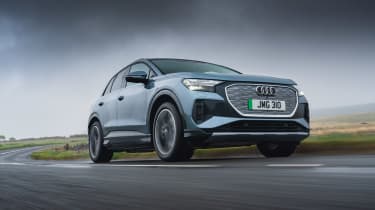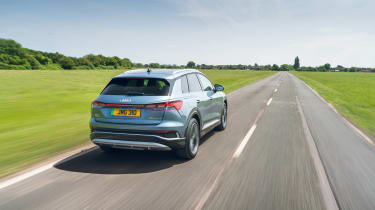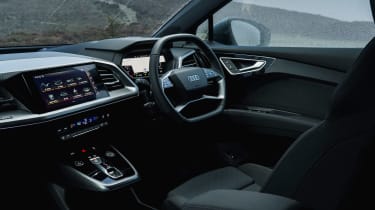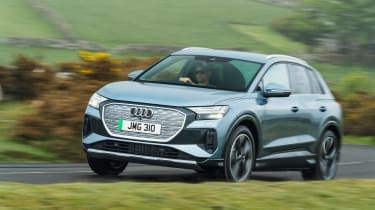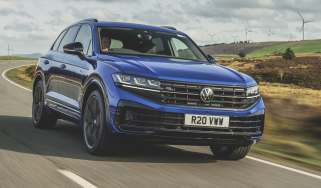Audi Q4 e-tron 2021 review – a premium take on VW’s ID.4?
The new Q4 is wide of the mark in key areas, but is sure to sell in numbers that will deem this irrelevant
The new midsize Audi Q4 e-tron is an important car for the premium German marque, as not only does it push ahead with Audi’s electric car agenda, but it will also be the model to democratise its EV range, costing far less than its expensive e-tron SUV and GT. As a result, Audi is ambitiously forecasting the new Q4 will be its second-highest-selling model in the UK behind the A3 in the next two to three years, filling its niche with a spread of variants in two body styles. Yet while Audi’s sales forecasts are likely to be proven right, the actual car it has built for the job is what we’re more interested in, as this third all-electric model from Audi should take on board everything it has learnt from its other EV models and bundle it into a more affordable and commercially lucrative package.
Peel away the skin and you’ll notice that this Audi takes its underpinnings from Volkswagen, adopting the MEB platform shared with the ID.3 and ID.4, and also therefore Skoda’s Enyaq and Cupra’s Born. Yet Audi has arguably jumped the gun with its Q4, as while it may have been beaten onto the market by most of its cousins, with two body styles, battery packs and powertrain layouts available from launch, the Q4 is already the most diverse of its extended VW family.
More reviews
Group tests
- Aston Martin Vantage V600 v Aston Martin Vantage GT8 – limited-run Astons go head-to-head
- Aston Martin Vantage vs Audi R8 V10 RWD – back to basics
- BMW E30 M3 v E46 M3 CSL v F87 M2 CS
- BMW M8 Competition Gran Coupe vs Audi RS7 Sportback – battle of the alt-supersaloon
- Caterham Super Seven 600 v Super Seven 2000
- Levante v T1
- Corvette Stingray v Porsche Cayman GTS v Audi R8 RWD
- Hardcore Ferrari V8 specials go head-to-head
- Evolution of the Ferrari GT: 365 GTB4 Daytona to the 812 Superfast
- Lamborghini Aventador Ultimae v Lamborghini Countach
In-depth reviews
- Audi RS7 Sportback Performance review
- Bentley Continental R Mulliner: review, history and specs
- BMW M5 Touring (E61, 2007 - 2010): review, specs and buying guide
- BMW X7 review
- Cupra Leon review
- Genesis G70 review
- Ginetta G56 GTA review – a fabulous portal into the world of motorsport
Long term tests
- Alpina B10: end of term report
- Alpina B10
- Alpina B10
- Alpina B10
- Ford Mustang GT
- Ford Mustang GT
- Ford Mustang GT
- Hyundai i30 N Fast Fleet test – 8 months with the Korean hot hatch
- Mitsubishi Evo MR 340
- Mitsubishi Evo MR 340
Review
- New Aston Martin DBS 770 Ultimate review – 759bhp super-GT driven
- New Bentley Batur 2023 review – can it possibly be worth £1.65m?
- 2023 Chevrolet Corvette C8 Z06 review – the American 911 GT3?
- Kia EV6 GT-Line S prototype review – the EV that shows how it’s done
- BBR Supercharged Mazda MX-5 (ND) 2023 review – tuned 250bhp roadster driven
- MG4 Trophy 2023 review
Reviews
- Abarth 500e 2023 review
- AC Cobra 378 Superblower MkIV 2021 review – another V8 Cobra, but with a GM heart this time
- Alfa Romeo Tonale 2023 review – 276bhp Speciale version tested
- Alfa Romeo Giulia Veloce 2023 review
- Alfa Romeo Giulia GTAm 2021 review – if Porsche built a four-door 911 GT3 RS
- Alfa Romeo SZ: history, review and specs of an icon
- Alfa Romeo 1750 TBi
Its connection to these models is clear, as underneath the complex (some might say fussy) bodywork is a familiar cab-forward silhouette, long wheelbase and short overhangs. Both standard and Sportback bodies are styled identically, save for the latter’s roofline which dips down towards the rear giving it a fastback rear end.
Entry-level cars make do with just a single rear-mounted motor with either 167bhp or 204bhp outputs, but it’s the 300bhp dual-motor option we’re driving here which adds a motor to the front axle, also making it all-wheel drive. All variants are then powered from a battery pack that lies under the cabin floor, with the motors integrated into the axles. Battery options are either 52kWh or 77kWh, with the smaller pack reserved for the entry-level 167bhp variant. Real-world range is competitive across the board, with single-motor variants paired with the larger battery pack capable of around 300 miles (323 miles claimed), although dual-motor variants are more likely to hover around 250-270 miles (295 miles claimed).
So with all this shared hardware how does the Q4 justify its premium status? Audi says this is through peerless design excellence, build quality and technology, something the company has largely managed to achieve during its transformation over the last two decades. And it’s these qualities the new Q4 needs to portray, as the £4000 premium over the cost of the larger ID.4 and Enyaq needs to be explained somehow.
Step inside the Q4 and the interior you’re greeted with has a complex arrangement of shapes and materials that are increasingly typical of modern Audis. Scratch below the surfaces, though, and substance is lacking. While it’s well constructed and spacious, material quality is average at best, and the digital interfaces are fine but certainly not class leading. It’s hard not to compare it to its closely related brethren, and when Skoda’s Enyaq offers such a plush alternative considering its lower price point, the Audi’s prestigious aspirations begin to look a little ambitious.
This is felt once on the road, too, as the ride quality lacks sophistication, the Q4 often crashing into intrusions and pogo-ing over the road surface as both the front and rear axles run out of ideas on anything other than a dead-smooth road. Our specific car was riding on 20-inch wheels (21s are optional) and the S-line suspension set-up, but it’s likely the lack of adaptive dampers that sealed this specific Q4’s fate. The stiff suspension doesn’t really help around corners either, as the 2135kg kerb weight makes it feel like a very blunt instrument. Admittedly, few manufacturers have gotten their heads around how to properly set up electric cars yet, but the Q4 is resoundingly average, especially compared to EV rivals such as the Kia EV6.
What’s especially disappointing, though, is that the Q4 feels nothing more than moderately brisk, its punch diluted by that mass it’s tasked with propelling. Low-to-mid-speed throttle and brake calibration is fine, but both struggle to execute linear smooth operations, while the brakes themselves, like many of VW’s MEB products, don’t have the bite you’d expect of a car weighing the wrong side of two tons.
Yet thinking about the Q4 e-tron from a buyers perspective, this lack of coherency won’t likely be enough to deter buyers. It trails most rivals in most areas, and while it’s not ostensibly a bad car, we’re not sure it’s good enough either.
Prices and rivals
As mentioned, all Q4s cost over £40,000, the range opening with a 167bhp single-motor Sport variant with a 52kWh battery pack, rising right up to and over £65,000 for the dual-motor Vorsprung. Model-for-model, this is about £4000 more than the larger Skoda Enyaq and Volkswagen ID.4, with the more potent Skoda Enyaq Coupe vRS priced from £51,885.
While its in-house rivals (specifically the Skoda) have a small lead on the Audi, it’s actually competitors from outside the group that will prove to be the Q4’s biggest threat. The Kia EV6 right now is the standout electric vehicle at this price point, not only offering an improved value proposition but also being significantly better to drive. Hyundai’s Ioniq 5 is also a consideration, and is a far more distinctive option with its Blade Runner design and class-leading interior.
This is the state of things in 2021. Audi has been outgunned by rivals from Hyundai and Kia, and Skoda’s cheaper variant has a big march on interior ambience and build quality. Yet Audi’s brand cache is still leagues ahead of those of all concerned, and for the premium electric SUV customer that’ll likely be enough to ensure its sales success.

